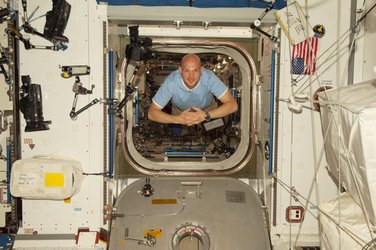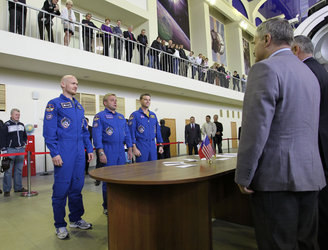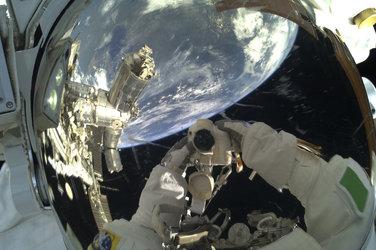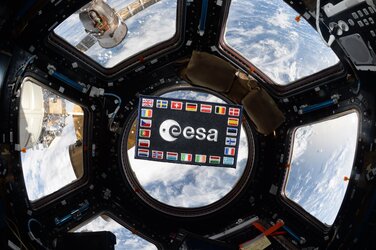Mission patches
The International Space Station is a cooperative effort between five space agencies and countries from all over the world. Alexander Gerst’s Blue Dot mission was also part of the Soyuz 39S mission to the International Space Station and back. While onboard, Alexander was part of Expedition 40 and 41.
Blue Dot
The mission name and logo are inspired by an image of Earth taken by NASA’s Voyager spacecraft as it travelled six billion kilometres from our planet. American astronomer Carl Sagan described our faintly visible planet on the photograph as a “pale blue dot”.
From afar, our planet looks like a fragile vessel that needs protecting. The logo was designed as a blue sphere representing Earth. An icon of Earth appears in the patch protected by two hands to show that it is important to take care of our planet – it is the only spaceship we have.


Access the video
Soyuz TMA-13M

The spacecraft that carried Alexander and his Russian commander Maxim Surayev with NASA astronaut Reid Wiseman is the trusty Soyuz. Their model was the Soyuz TMA-13M.
The Soyuz TMA-13M mission patch was created by Dutch designer Luc van den Abeelen for Roscosmos, featuring a famous monument in the town of Baikonur near the launch site. A cosmonaut with open arms is floating over a blue Earth with a Soyuz launcher climbing towards the stars. The original statue is called ‘Weightlessness’, but locals call it ‘the fisherman’.
The star constellation on the patch is Cepheus, which is also commander Maxim’s callsign. Surrounding the patch are the crew’s last names, national flags and spacecraft name.
Expedition 40

Expedition 40 started when Alexander, Maxim and Reid arrived at the Space Station. On 26 March 2014 the other three members of Expedition 40, cosmonauts Alexander Skvortsov and Oleg Artemyev with NASA astronaut Steve Swanson left for the Station in their Soyuz.
The Expedition 40 patch depicts the past, present and future of human space exploration. The crew explain their patch in their own words: “The reliable and proven Soyuz, our ride to the International Space Station, is a part of the past, present and future. The Station is the culmination of an enormouseffort by many countries partnering to produce a first-class orbiting laboratory, and its image represents the current state of space exploration.
“The Station is immensely significant to us as our home away from home and our oasis in the sky. The commercial cargo vehicle is also part of the current human space exploration and is a link to the future. A blend of legacy and future technologies is being used to create the next spacecraft that will carry humans from our planet to destinations beyond.
“The Sun on Earth’s horizon represents new achievements and technologies that will come about due to our continued effort in space exploration.”
The patch features the names of the first expedition astronauts in the smaller circle and Alexander and crewmates on the outer circle. The number 40 is written in Roman numerals.
Expedition 41

When the Soyuz TMA-12M spacecraft undocked with the Space Station in September 2014 it carried Alexander, Oleg and Steve back to Earth and marked the beginning of Expedition 41. The next three-person crew arrived shortly afterwards to complement Expedition 41: cosmonauts Alexander Skvortsov, Oleg Artemyev and NASA astronaut Steve Swanson. Expedition 41 lasted until the end of Alexander Gerst’s Blue Dot mission.
The patch was designed by the Expedition 41 crew and Blake Dumesnil. The crew write: “Portraying the road of human exploration into our vastly unknown universe, all elements of the Expedition 41 patch build from the foundation, our Earth, to the stars beyond our Solar System. The focus of our six-month expedition to the International Space Station is Earth and its inhabitants, as well as a scientific look out into our Universe.
“The distinguishing solar arrays reach onward and serve as the central element, with the icon of an atom underneath representing the multitude of research on board that will bring new discoveries for the benefit of humanity. The Sun is rising over Earth’s horizon, spreading its light along the road of human exploration.
“Equipped with the knowledge and inspiration gained from the International Space Station, our successful multinational cooperation will lead human space exploration to the Moon, Mars, and ultimately, the stars. We are Expedition 41. Join us for the adventure."














 Germany
Germany
 Austria
Austria
 Belgium
Belgium
 Denmark
Denmark
 Spain
Spain
 Estonia
Estonia
 Finland
Finland
 France
France
 Greece
Greece
 Hungary
Hungary
 Ireland
Ireland
 Italy
Italy
 Luxembourg
Luxembourg
 Norway
Norway
 The Netherlands
The Netherlands
 Poland
Poland
 Portugal
Portugal
 Czechia
Czechia
 Romania
Romania
 United Kingdom
United Kingdom
 Slovenia
Slovenia
 Sweden
Sweden
 Switzerland
Switzerland




















































